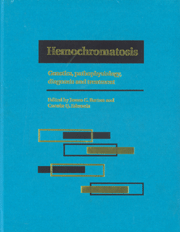Book contents
- Frontmatter
- Contents
- List of contributors
- Foreword
- Part I Introduction to hemochromatosis
- Part II Genetics of hemochromatosis
- Part III Metal absorption and metabolism in hemochromatosis
- 10 Intestinal iron-binding proteins
- 11 Intestinal iron absorption and hemochromatosis
- 12 The absorption and metabolism of non-ferrous metals in hemochromatosis
- 13 Ferritin metabolism in hemochromatosis
- 14 Hepatic iron metabolism in hemochromatosis
- 15 Extra-hepatic iron metabolism in hemochromatosis
- 16 Mathematical models of metal metabolism in hemochromatosis
- 17 Expression of iron overload in hemochromatosis
- Part IV Diagnostic techniques for iron overload
- Part V Complications of iron overload
- Part VI Therapy of hemochromatosis and iron overload
- Part VII Infections and immunity in hemochromatosis
- Part VIII Hemochromatosis heterozygotes
- Part IX Relationship of hemochromatosis to other disorders
- Part X Animal models of hemochromatosis and iron overload
- Part XI Screening for hemochromatosis
- Part XII Hemochromatosis: societal and ethical issues
- Part XIII Final issues
- Index
11 - Intestinal iron absorption and hemochromatosis
from Part III - Metal absorption and metabolism in hemochromatosis
Published online by Cambridge University Press: 05 August 2011
- Frontmatter
- Contents
- List of contributors
- Foreword
- Part I Introduction to hemochromatosis
- Part II Genetics of hemochromatosis
- Part III Metal absorption and metabolism in hemochromatosis
- 10 Intestinal iron-binding proteins
- 11 Intestinal iron absorption and hemochromatosis
- 12 The absorption and metabolism of non-ferrous metals in hemochromatosis
- 13 Ferritin metabolism in hemochromatosis
- 14 Hepatic iron metabolism in hemochromatosis
- 15 Extra-hepatic iron metabolism in hemochromatosis
- 16 Mathematical models of metal metabolism in hemochromatosis
- 17 Expression of iron overload in hemochromatosis
- Part IV Diagnostic techniques for iron overload
- Part V Complications of iron overload
- Part VI Therapy of hemochromatosis and iron overload
- Part VII Infections and immunity in hemochromatosis
- Part VIII Hemochromatosis heterozygotes
- Part IX Relationship of hemochromatosis to other disorders
- Part X Animal models of hemochromatosis and iron overload
- Part XI Screening for hemochromatosis
- Part XII Hemochromatosis: societal and ethical issues
- Part XIII Final issues
- Index
Summary
Introduction
Idiopathic hemochromatosis is a familial genetic disorder in which iron absorption consistently exceeds losses of body iron. This leads to accumulation of iron in multiple body organs.When iron concentrations become sufficiently excessive, cellular damage and destruction occur with organ dysfunction and failure. This may become manifest as either cirrhosis of the liver, hepatocellular carcinoma, diabetes mellitus, cardiomyopathy, hypogonadism, or arthritis, or a combination of these disorders. Because hemochromatosis usually becomes clinically manifest during the fifth and sixth decades of life, it usually takes many years of iron accumulation before a homozygote seeks medical attention. Presumably, this long delay occurs because body organs possess a capability to store iron far in excess of body needs. Once the iron-binding capacity of tissues are exceeded, ionic iron becomes available to produce ‘free radical’ formation and cellular damage. An enigma that remains unexplained is that studies of the prevalence of homozygous hemochromatosis in Caucasians (∼0.6%) indicate that genotypic hemochromatosis is at least ten times more commonplace than clinically manifested phenotypic hemochromatosis (1 in 20000 hospitalizations). This suggests that factors in addition to a single genetic mutation are necessary to produce massive iron overloading with organ damage.
Although the genetic defect for about 85% of Caucasian hemochromatotics was recently identified (HLA-H, C282Y), the method by which it enhances iron accumulation by the body remains unknown. One possibility is that the genetic abnormality acts directly upon the intestinal absorptive cell to enhance the absorption of iron.
- Type
- Chapter
- Information
- HemochromatosisGenetics, Pathophysiology, Diagnosis and Treatment, pp. 118 - 130Publisher: Cambridge University PressPrint publication year: 2000
- 2
- Cited by



